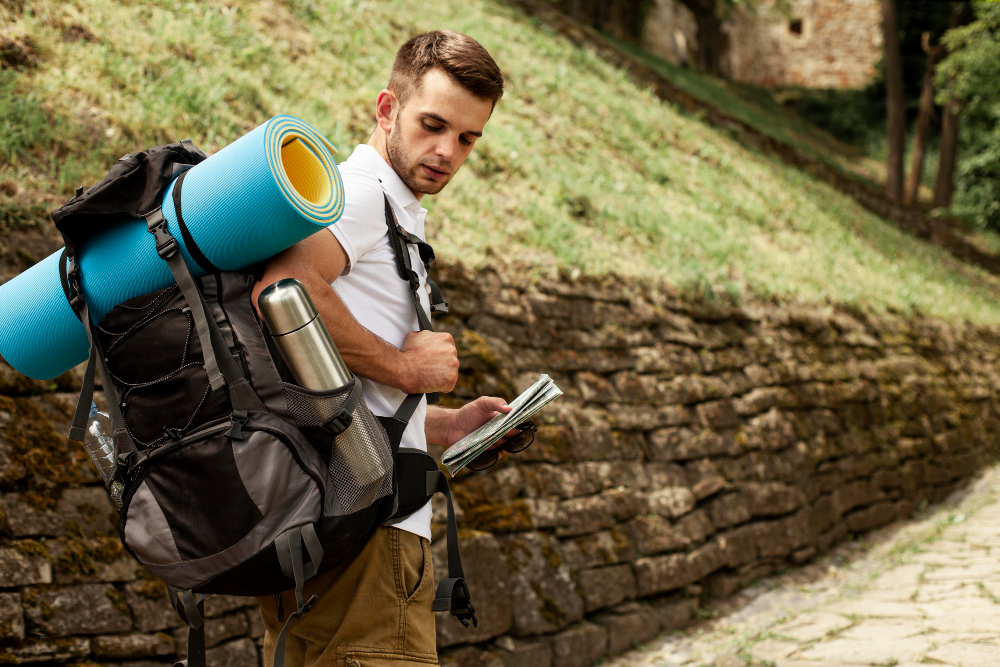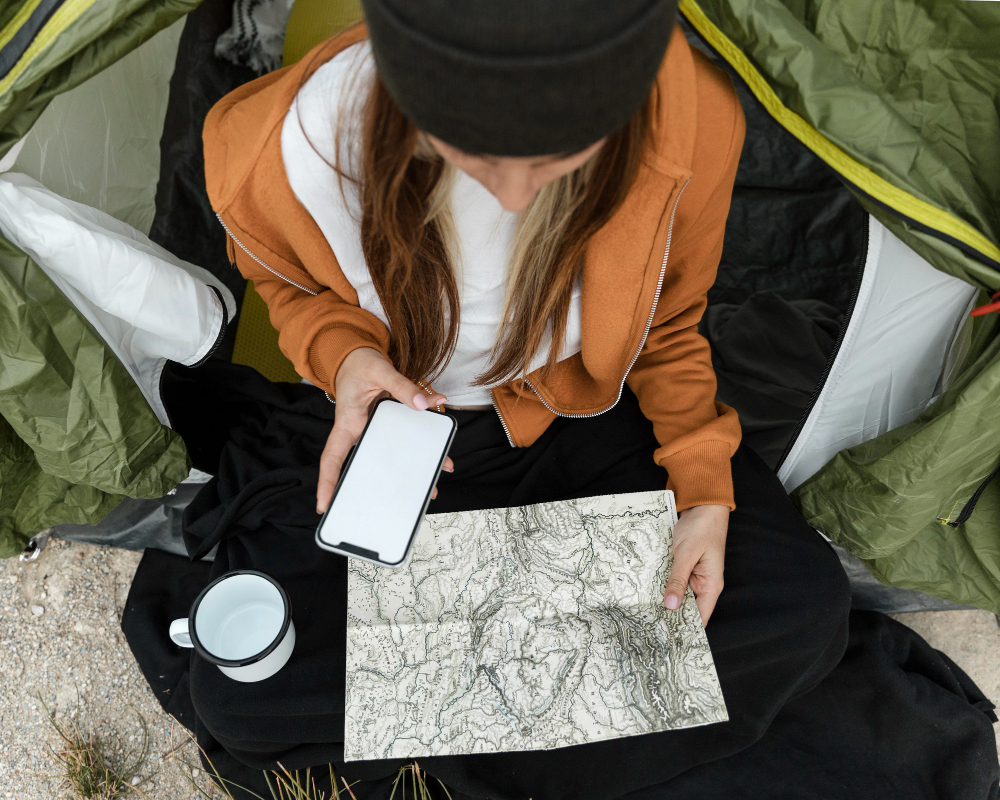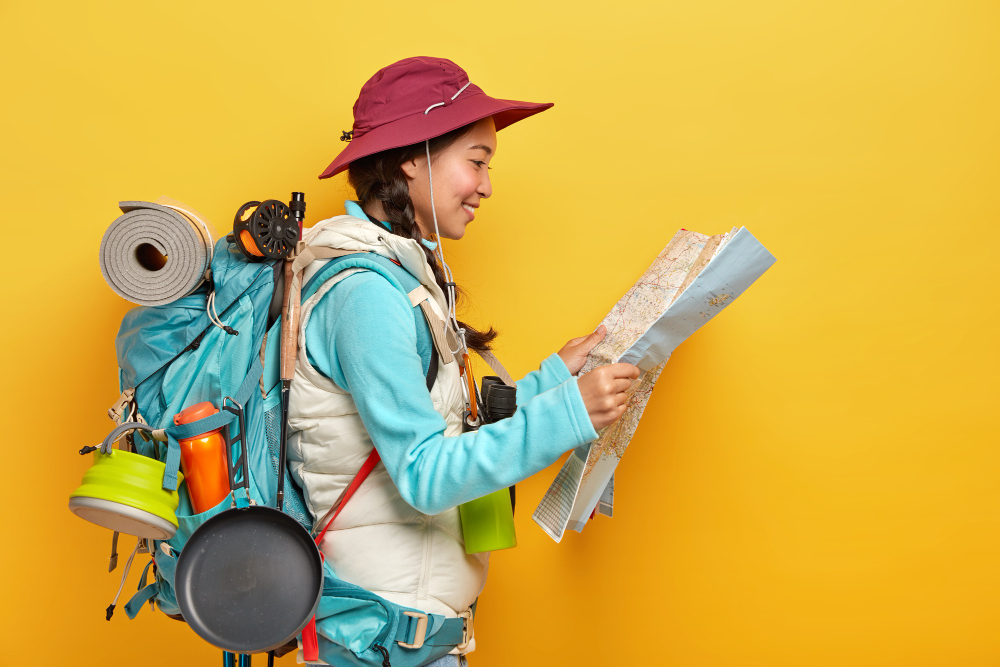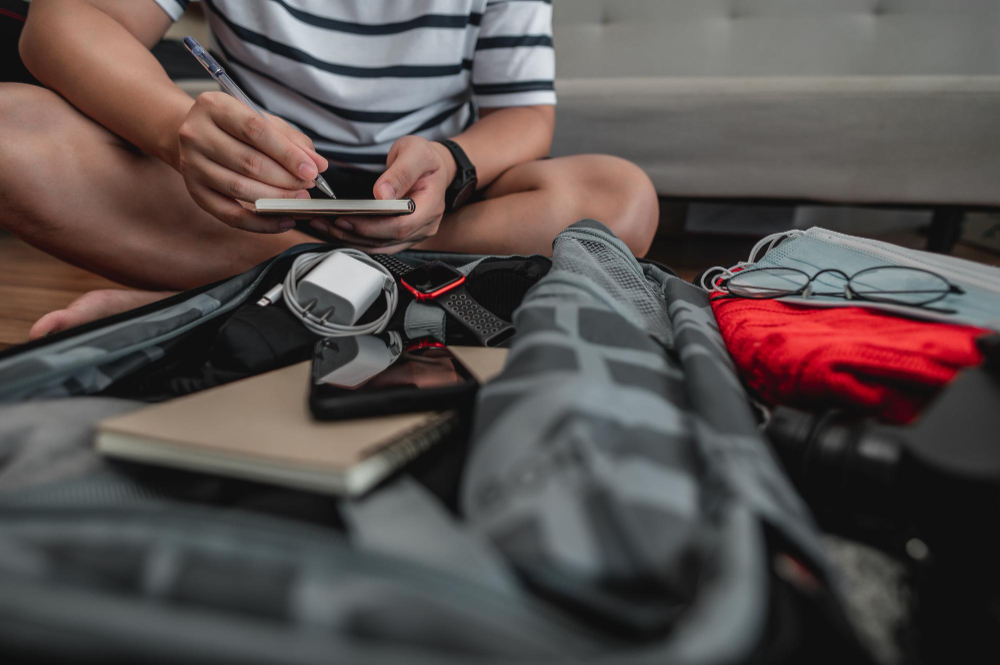A backpacking checklist lists the necessary goods and equipment for a journey. It guarantees all you need for a risk-free and fun outdoor trip. The items on the list include the backpack, tent, sleeping container, pad, cooking utensils, emergency preparedness materials, clothes, footwear, the water supply of water and food, and personal goods.
Before leaving, you must verify the weather and the state of the trails, and depending on how long and challenging your journey will be, you may need to modify the items on the backpack checklist.
What is a Backpack Chesklist?
Going backpacking is fun to experience nature, connect with it, and push your physical and mental limits. Proper equipment and supplies are essential to guarantee a safe and pleasurable journey, whether going on a multi-day hike into the wilderness or camping in a remote area. Make sure you have all the essential equipment and supplies for your backup checklist. A backpacking checklist helps you pack successfully and quickly. In this post, we’ll look at the different things that should be on a backpacking checklist and offer advice on how to customize the list to suit your needs.
Why is it Essential to Make a Checklist for Backpacking?
A checklist may help ensure you have all the necessary safety equipment, including a first-aid kit, navigational aids, and emergency supplies. This can be extremely important in the case of a mishap or an unanticipated emergency.
Avoid Overpacking
By keeping track of the necessities you’ll need for your vacation, a checklist can help you avoid overpacking. Packing may render your backpack lighter, making it for extended distances uncomfortable and tiresome.
Importance of Making a Checklist
Making a checklist will help you avoid forgetting essential items and save time and money by preventing you from rushing through last-minute purchases.
Enhancing Enjoyment
Going on a backpacking trip may be more fun and less stressful if you have all the required supplies and equipment. Instead of stressing out over missing anything crucial, you may concentrate on taking in the beauty of the natural world.
Note:
In conclusion, creating a backpacking checklist is crucial for ease, enjoyment, and safety. It also helps guarantee a successful and fulfilling journey.
Backpack Gear
The necessary supplies and equipment for a hiking journey are known as backpack gear. It consists of a backpack, camping gear, cooking supplies, emergency equipment, clothes for the trek, and boots. Your choice of equipment will be influenced by the duration and complexity of your journey and the terrain and climate of your final destination.
Packaging well is crucial to prevent your backpack from becoming too heavy and to buy lightweight, reliable gear that fits your needs.
A Backpack
A bag style called a backpack is made to be worn on the back. It is frequently used for outdoor pursuits like hiking, camping, and backpacking since it lets you transport necessary supplies and equipment while preserving your hands-free position.
Backpacks come in various shapes and sizes, with varying functions and storage areas to meet multiple demands. A decent backpack should fit your body well, be sturdy, and be the right size for the number of things you must carry.
Consider the kind of activity you’ll be doing, how long your vacation will last, and your personal comfort and style preferences when selecting a backpack.
How to choose the Right Backpack?
Selecting the appropriate backpack is essential for a successful and comfortable backpacking trip.
Here are some pointers to assist you in selecting the ideal backpack:
Choose the Proper Size for your Needs:
Backpacks are available in a different range of capacities. Select a pack that is the right size for the kind of gear you will need to carry and the length and challenge of your trip. Generally, a weekend trip could call for a backpack of anywhere from thirty to fifty liters, while more extended travels might call for a more oversized bag.
Think About the Fit:
On your body, a backpack ought to sit securely and pleasantly. Select a backpack with padded shoulder straps and a hip belt for greater comfort, and search for one that is adjustable according to your body length and hip size.
Verify the Weight:
The backpack ought to weigh light to ease the physical strain while still being tough enough to survive the effects of trail use. Look for backpacks composed of durable yet lightweight materials like Cordura or ripstop nylon.
Inspecting Features:
The number and size of pockets, the method of closing (zipper and drawstring), external attachments for essential gear, including trekking poles and a sleeping pad, and any unique features, including hydration compatibility, should all be taken into account.

Try it on:
Always try wearing a backpack before buying one to guarantee a perfect fit and degree of comfort. Put weight in the backpack to represent how much baggage you’ll carry throughout your journey, then take a walk to understand how it feels.
Note:
By considering these elements, you can select a backpack that will be practical and comfortable for your backpacking trip.
Features to Look for in a Backpack
There are several key characteristics to consider when buying a backpack for hiking.
Here are some critical aspects to think about:
Material:
Seek out backpacks constructed of strong yet lightweight materials like nylon or polyester. These materials must be water-resistant or coated with a waterproof substance to safeguard your equipment in damp situations.
Capacity:
Select a backpack that has a suitable capacity based on the length and complexity of your journey. Typically, a weekend getaway may need a bag between 30 and 50 liters; however, bigger backpacks can be required for extended trips.
Comfortable Backpacks:
Look for comfortable backpacks with cushioned shoulder straps, a hip belt, and a permeable back panel. These elements will lessen discomfort and perspiration by distributing the heaviness of the bag.
Compartments:
To help you manage your things, consider purchasing backpacks with lots of pockets and compartments. Backpacks typically include a top-loading main room, but some could also have a front-loading panel with side pockets for quick access.
Suspension system:
Seek out backpacks with an adjustable suspension system that can be molded to your body. This includes load lifters, hip belts, and adjustable shoulder straps. For attaching equipment like hiking poles, ice axes, and sleeping pads, look for backpacks incorporating external attachment points like loops or straps.
Water reservoir compatibility:
Some backpacks come with an embedded hydration system, including a hydration sleeve. Find backpacks that are compatible with the hydration system of your choice.
Note:
You may choose a backpack that’s practical, comfortable, and fulfills your unique demands for hiking by taking these aspects into account.
Shelter and Sleeping Gear
Any backpacking checklist must include shelter and sleeping supplies.
Here are some crucial things to think about:
Tent:
A camping tent should be compact, strong, and simple to erect. For the number of people in that group and the weather you anticipate, try to find a tent that is the right size. Some tents are made with particular seasons and weather conditions in mind.
Sleeping Bag:
A decent backpacking sleeping bag must be warm, lightweight, and compressible. Opt for a bag to use for sleeping that features a temperature rating suitable for the anticipated weather, and base your decision on whether you like down or synthetic fill.
Sleeping pad:
A sleeping pad protects you from the ground by cushioning and insulating you. Choose something easily portable, comfortable, and light. You may pick from various materials, such as foam, air, or self-inflating pads.
Hammock:
A type of hammock is a convenient and lightweight tent substitute. Find a hammock that can support your weight, and think about adding extra features like a rain fly or a built-in bug net.
Bivy bag:
A bivy sack is a minimally protective, lightweight, and portable alternative to a tent. A bivy sack that is the right size for a tent should be composed of breathable, waterproof fabrics.
Shelter accessories:
To maintain your shelter outdoors, accessories such as tents, guylines, and repair kits are crucial. In situations involving damage or loss, always have extra stakes and guylines.
Note:
You can enjoy your hiking experience while being safe and comfortable by selecting the proper shelter and sleeping equipment.
Cooking Gear and Supplies
For any backpacking trip, cooking equipment and supplies are essential because they let you make hot meals and beverages in the wilderness.
Here are some crucial things to think about:
Stove:
A backpacker stove is a small, portable appliance to heat meals and liquids. Choose a cooking device that is portable, lightweight, and simple to operate. Stoves come in various designs, including canister, liquid fuel, and wood-burning models.
Cookware:
Backpacking cookware has to be strong, lightweight, and small to fit within your bag. A pot, a cover, and sometimes a pan, as well as a skillet, should all be part of a set. Popular materials for cookware used when camping include titanium or aluminum.
Water Filter as well as Purification System:
Having a dependable way to cleanse water outdoors is essential. From natural water sources, hazardous bacteria and protozoa can be eliminated via a water filter and a purification device. Choose an approach that is both portable, user-friendly, and efficient.
Fuel:
Pack enough fuel for your stove to run continuously throughout your journey. Your type of stove will determine the kind of fuel you need.
Other Applies:
Matches, a lighter, a saucepan holder or deliberately gripped pad, a toothbrush or sponge when cleaning, a stuff sack, and a mesh bag for keeping your cookware are examples of additional materials.
Note:
You may enjoy hot food and refreshments in the wilderness, keep hydrated, and sustain your energy levels during your journey by taking the proper cooking equipment and materials.
Emergency and Safety Gear:
Any backpacking checklist should include emergency and safety equipment because it can keep you safe in an emergency.
Here are some crucial things to think about:
First aid Kit to Add in Backpack Checklist:
A first aid pack should have bandages, antiseptic wipes, painkillers, and medicines for allergic reactions to treat common injuries and diseases in the wilderness.
Map and Compass:
Bring a map and a compass; as a backup, use a GPS or smartphone app. Make sure you understand how to use these tools for backcountry navigation.

Lighting:
You’ll need a headlamp and flashlight when it’s dark or low light. Bring additional batteries or a portable power source.
Emergency Shelter:
A portable emergency shelter can shield you from the elements if you get lost or stranded. Choose a cover that is wholly portable and simple to erect.
Whistles and signal mirrors: These devices can signal for assistance in an emergency.
Knife or Multi-tool:
A knife or multi-tool may perform various jobs, such as chopping food and fixing equipment.
Personal Locator Beacon (PLB) or Satellite Messenger:
Personal locator beacons (PLBs) and satellite messengers may be used to contact rescuers and send distress signals in an emergency.
Note:
You can be ready for unforeseen circumstances and maintain your safety throughout your backpacking trip by including the appropriate emergency and safety kit.
What to pack for first aid?
A first aid kit must be packed on hiking to treat frequent injuries and diseases outdoors. Consider including the following essentials in your first aid kit:
- Bandages and Gauze: should be provided, as well as adhesive tape and gauze pads for bigger wounds. Bandages should be available in a range of sizes and shapes.
- Painkillers: Over-the-counter painkillers like acetaminophen and ibuprofen can help soothe pain and lessen inflammation.
- Antihistamines: Bring antihistamines with you if you have adverse reactions like bee stings or food sensitivities.
- Blister remedies: Cover your feet with moleskin and blister pads to prevent blisters and hot spots.
- Tweezers and Scissors: can be used to cut tape and bandages, remove splinters, and clip nails.
- Thermometer: Bring an accurate thermometer to check your body temperature if you have a fever.
- Personal Medications: Pack enough to last the excursion duration if you use any prescription drugs or nutritional supplements.
- First Aid Guidebook: A compact guidebook can offer instructions on utilizing the supplies in your bag and give details on typical illnesses and injuries in the wilderness.
Note:
A first aid kit should be tailored to your particular requirements and location, and you should always keep it nearby in an emergency.
Clothing in Backpack Checklist
Any backpacking checklist should include clothing because it can keep you warm, dry, and protected in various weather conditions.
Here are some crucial things to think about:
Base layers:
The bottom layers help you maintain a comfortable body temperature by wicking moisture away from your skin. Bring wool or synthetic clothing in both the top and bottom layers.
Insulating layers:
Insulating layers like down or fleece coats keep you warm in colder climates.
Outer layers:
Bring a waterproof, breezy jacket or rain poncho to shield yourself from wind and rain. Bring comfortable hiking pants and shorts that are lightweight, quick-drying, and allow for layering for warmth.
Pants and Shorts:
Choose hiking footwear, such as boots, that accommodate you well and have been broken in well before your trip. They should be supportive and comfy. Bring additional socks to protect your feet from blisters and keep them dry.
Headwear:
Include a sun hat to shield your scalp and face from the sun and a beanie or other warm hat for colder weather.
Gloves:
Bring warm gloves or mittens as well as light gloves for sun protection.
Swimwear:
Pack a swimsuit or some shorts if you intend to go swimming.
Sunglasses:
Sunglasses shield your eyes from glare and dangerous UV radiation.
Take Note of the Following:
When packing clothing, remember how the weather is at your destination, and always try to bring layers that can be easily combined.
Footwear and Socks
The correct socks and shoes are essential for a safe and pleasant hiking trip. Here are some crucial factors to remember:
Hiking Boots as well as Shoes
Opt for a pair that fits well, is comfortable, and has adequate traction. If you want to hike in damp conditions, look for something waterproof or a water-resistant alternative.
Socks:
Prepare several comfortable, breathable socks constructed from synthetic or wool fibers. Please stay away from cotton since it traps moisture and can cause blisters.
Gaiters:
These help keep snow, ice, and other elements out of your boots. Consider bringing them if you plan to go across rough terrain or damp weather.
Sandals and water shoes:
Consider carrying sandals or other water shoes if you intend to cross waterways or spend some time near water for increased comfort and security.
Shoelaces and Repair Kit:
Extra shoe laces and a repair kit should be included in case of damage. The repair kit should consist of duct tape and a multi-tool for quick fixes.
Inscription:
Consider the conditions and temperature of your location when selecting your shoes and socks, and break in any new footwear you purchase before your journey to avoid blisters and discomfort.
Food and Water
Any backpacking trip must include sufficient food and water supplies because they provide the fuel and hydration needed to maintain energy levels and avoid dehydration.
Listed below is some advice about bringing food and water:
Water:
Pack enough water to last the entire trip, and think about packing a water filter or other purification pills to purify water from lakes or streams.
Water Bottles and Hydration Systems:
Recreate enough water bottles and hydration systems to transport all your water needs. Consider taking an additional water bottle or hydration bladder in case of breakage or leaks.
Food:
Select foods that are easy to carry, non-perishable, and high in energy, including trail mix, energy bars, dried meals, and instant noodles. Bring a range of snacks to avoid boredom and provide a balanced diet.
Cooking Equipment:
Suppose you want to prepare meals while on your journey; pack a portable burner, a fuel canister, and a cooking pot. Verify if fires are permitted where you’re going, and pack a stove you can bring if they’re not.
Utensils:
Bring your lightweight cooking and eating utensils, such as a spork.
Food storage:
Consider packing your food inside a bear canister or another food storage container to protect it from wildlife.
Memorandum:
Consider the length of your journey, your anticipated caloric requirements, and the accessibility of water sources to reach your destination when planning your food and water supplies. In an emergency, bring extra food and water and properly dispose of garbage to reduce the environmental impact.
Personal Items
The personal items needed for backpacking are listed below:
- Remember your cell phone and a charger. Try to bring a charger along with an adapter that has the function to adjust to any adapter.
- If you can source it, then try to bring the power bank.
- Try to bring the camera along with its charger.
- Your identity card is an essential thing to bring. The critical point is that you must have a photostat copy of your ID card.
- You must bring your passport and a ticket if traveling outside the country. Also, to take precautions, always photocopy your passport and visa.
Optional Extras
Hiking Poles:
Especially on steep terrain, hiking poles will help you stay balanced and lessen the stress on your knees.
Water Filter:
By removing the need to carry bulky water bottles, a water filter can allow you to get clean water from nearby streams or lakes.
Insect Repellent:
Use insect repellent to ward off mosquitoes and other pests and lessen the chance of getting bitten or stung.
Lightweight Camp Chair:
At your campground, a lightweight camping chair may offer a comfy seat, making it simpler to unwind and take in the scenery.
Solar-powered Lantern:
Without batteries, a solar-powered lantern may be charged throughout the day and offer light at night. Use caution around other campers and wildlife when using a portable speaker to play music or podcasts at the campsite.
Keep in Mind:
Nevertheless, while extras are optional, they make your vacation more pleasant and increase your pack’s weight. To make your suitcase as light as possible, carefully assess what you need and what travel can leave behind.
Important Points to Remember
Out of the many crucial ones, here are a few to keep in mind while backpacking:
Pack bright and light:
Carrying a big backpack can be exhausting and uncomfortable, so pack exactly what you need and avoid overpacking.
Plan and get ready:
Plan your itinerary and research the region you’ll be hiking in. Be ready for changes in the weather and terrain by packing a map and compass.
Stay hydrated as well as fuel:
Consume plenty of liquids and healthy food to maintain energy levels while hiking.
Be aware in the wild:
Be mindful of the possibility of coming into contact with animals, which include bears, snakes, and insects, and take the necessary safety precautions.
Stay safe:
Keep yourself safe by having a supply of first aid supplies and being knowledgeable about basic outdoor first aid. Carry a communication device, a cell phone, or satellite messenger, and let an individual know about your plans and scheduled return time.
Always put safety first, respect the natural world, and take pleasure in your backpacking trip.
FAQs
What not to forget while doing a backpacking checklist?
Only leave home with a map, compass, first aid kit, enough food and drink, suitable clothes and footwear, and a way to contact someone in an emergency.
How many clothes should I take backpacking?
Depending on how long your journey is, it’s advised to bring lightweight, layer-able clothing that dries quickly.
Are 40 liters enough for backpacking?
For experienced travelers who can carry little or for brief backpacking trips, a 40-liter backpack may be sufficient.
Are 50 liters enough for backpacking?
Especially for a longer backpacking journey and for less experienced travelers who may need to take extra stuff, a 50-liter backpack may be sufficient.
What is the weight of a 50L backpacking bag?
Depending on the components and design, a 50-liter backpack may weigh between 15 and 20 kilograms during backpacking.
How big is a 23-kg suitcase?
Depending on the manufacturer and the design, a 23kg suitcase’s dimensions can change, but they typically range from 65 to 75 cm in height and 40 to 50 cm in width.

Conclusion:
For individuals who enjoy adventure and the outdoors, backpacking may be a joyful and gratifying experience. It allows you to go to new locations, test your physical and mental limits, and escape the stress of everyday life. A productive backpacking trip requires planning and preparation, intelligent and minimal packing, adherence to the Leave No Trace philosophy, a focus on safety, and enjoyment of the adventure. Backpacking may be a wonderful experience that leaves you with lifelong memories if you approach it with the appropriate attitude and gear.

